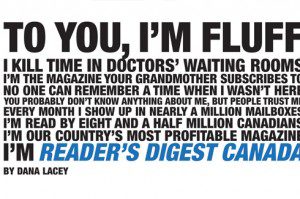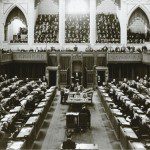To You, I’m Fluff …
But is there more to Reader's Digest?
To you, I’m fluff. I kill time in doctors’ waiting rooms. I’m the magazine your grandmother subscribes to. No one can remember a time when I wasn’t here. You probably don’t know anything about me, but people trust me. Every month I show up in nearly a million mailboxes. I’m read by eight and a half million Canadians. I’m our country’s most profitable magazine. I’m Reader’s Digest Canada.
Back in my heyday, my bylines belonged to journalism hotshots, presidents and Nobel Prize winners. I broke stories on AIDS before most other magazines dared to publish them. Through war, poverty and plagues, I told people that the world is not only a pretty good place, but can be made better, that life is what you make it, that laughter is the best medicine.
I’ve had access to celebrities, to politicians, to the Dalai Lama, to Donald Trump. Advertising giants have been seduced by my impressive consumer database, the biggest in the world. I’ve worked with the FBI, RCMP and Interpol for crime stories – my World’s Most Wanted feature even helped catch a murderer.
For nearly 60 years I’ve been unchallenged as the most-read, most-trusted name in Canada. But the pace of the world has quickened and being with-it got harder. Writing evolved and humour darkened, while I’ve stayed pretty much the same. More than half my readers are younger than 50, yet my sewing-circle reputation precedes me.
Lately I’ve felt the years creep up on me. I’ve treated myself to a few minor nips and tucks – I finally got that unsightly index-on-cover removed – but I must admit I’m no longer the fresh young publication I once was. In the industry nowadays, my name surfaces only when Print Measurement Bureau statistics come out, because I’m always No. 1. That’s still true, even though I’ve lost 20 per cent of my readership over the past decade.
I have to admit, my journalists’ words are rarely read by other journalists. I seem to have developed a bad reputation with the literati. I’m criticized for deflating the articles I reprint, stripping them of colour and style, theory and philosophy. CBC once defined “brain-dead” as “someone who enjoys Reader’s Digest.” Marshall McLuhan called me a “straightjacket” for independent thought, while both Ronald Reagan and Homer Simpson once called me their favourite magazine. “It’s like admitting you like Dan Brown,” says Peter Carter, editor of Today’s Trucking. “You just don’t want people to know.”
You may think you know me, but think again. The time has come to stamp out the stereotypes that keep me on the bottom shelf with the crossword puzzles. A lot has happened while you weren’t looking, such as the arrival of our hero, editor-in-chief Peter Stockland, in 2004. When he was editor-in-chief of The Gazette in Montreal, Peter gave the paper’s reputation a breath of life. For years they boasted that they sold “The English language. Daily” to Montrealers, but Peter decided the motto had outlived its usefulness and alienated the city’s Allophones. He updated the philosophy with a new slogan: “The Gazette is Montreal.” The broadsheet started to look vibrant again, so our hero looked for a new challenge. That’s when he heard my cry for help.
Peter gave it to me straight. “The Digest has itself to blame for its reputation,” he said. “It’s not a magazine that wants to rock the boat.” But rock the boat he has, and in the three years since our saviour stepped in, I’ve started to get noticed again. Peter’s plan to develop longer, more culturally engaging features, to bring long-form journalism back to the brand made famous by shortening articles, might work. I let a reprint of a Walrus magazine article run 21 RD pages at nearly 5,000 words because it was simply “too good to cut.” I published an exclusive with the Prime Minister after he had turned his back on members of the Parliamentary Press Gallery. I started exploring less-safe topics such as genocide in Darfur, Internet pedophilia and medicinal marijuana. Peter even has been trying to convince Canada’s top magazine writers to work for me.
Yet somehow I can’t shake the fear that I will never be recognized as a writer’s magazine. Just look at my name – I am the “reader’s” digest. My product is information, not ideas. I prefer fact over flair, practicality before personality. I tend to flatten copy with my relentless optimism, curtailing literary devices – bells and whistles, all of them. I look for the anecdote or the relatable character. “We’ve got to have faces and laughter and tears,” Peter says. “Heroes are a staple of Digest stories.”
When I tackle issues, I tend to play it safe by sticking to the unlikely-hero-overcomes-obstacles formula, such as last October’s feature – “The Greater Goal: Out of Sierra Leone’s civil war comes a unique soccer league that fosters hope.” I sell a better way of life. I see things in black and white, right and wrong, good and evil. I mass-produce hope. An article from 2005 says it all: “Gettin’ Better All the Time: Is the world really going to hell in a handbasket? Actually, no.”
But my latest problem has no easy solution. Our hero sums up the growing crisis only too well: “Readers started at a particular point in their lives and have been loyal for many, many, many, many years,” Peter says. “We have to be concerned that the group coming after them isn’t going to start. When that happens, it’s the end.”
Dewitt “Wally” Wallace, a college dropout who didn’t much like to read, dreamed up the original RD, my American older brother, during the First World War. He conceived it as a pocket-sized publication – the bane of today’s art directors. The Little Aristocrat, which was the working name of the magazine before the first issue, promised to condense articles “of lasting interest” from the most important books and magazines. These days Peter calls me a “content aggregation company,” but back then my role was to amass information editors thought people should know, for those who didn’t have the interest, education or attention span to find it elsewhere. Inspired by Henry Ford – the “dreamer and worker” appeared in the first issue in 1922 – Americans eagerly devoured Wally’s neat and tidy approach to life. Henry made cars anyone could drive and Wally made literature anyone could read. The reader would learn a little about a lot – how M&M’s are made, what it feels like to be shot, the numerous uses of sand. I made money during the Depression when people were willing to shell out for a bit of hope. When a paper shortage caused by the Second World War made magazines a highbrow luxury, my subscription list actually grew. Some claim Wally found “the journalistic philosopher’s stone,” a way to hold the interest of a diverse, faithful and enormous readership. I’m a household name, known worldwide for my sunny-side-up outlook and water cooler tidbits. “When we’re talking influence, there is no competitor,” the book The Condensed World of the Reader’s Digest said of my family. “[It] makes all the others look like a rose petal being dropped down a canyon, waiting for an echo.”
The 1940s were a busy time for Pop. The RD empire Wally and his wife Lila had built over the previous 20 years in Pleasantville, N.Y. had become hugely profitable. My big brother had outgrown his pony shed, so Wally and Lila moved him to Chappaqua, N.Y. Yet even today – 68 years after the big move – the flagship has kept the more optimistic mailing address.
When Wally built the next office – a mansion – Lila requested a bell tower flanked by great, winged horses. She loved the myth that a stamp from Pegasus’s hoof inspires men to write. Wally’s gaze shifted to the rapidly expanding Canadian market, hungering to get a piece of those virgin advertising dollars while respecting our country’s local content quotas. Wally discovered he could save a lot of time and money if he wasn’t physically involved in the production of his new baby.
I was born in 1948, before television and rock ‘n’ roll hit the scene. I’m a baby boomer and only a small part of a giant empire that pumps out books, magazines, gifts, music and videos. Like the rest of my family, I take after my big brother – I’m identical in size, politics and philosophy (work hard and you can achieve anything). I look just like my 50 foreign siblings and together we deliver hope in 21 languages. We sit politely on shelves, quietly trumpeting our determined viewpoint to 100 million minds across 61 countries.
During my first few decades, I thrived on hand-me-down content. Called adaptations, a writer takes the original article along with strict, specific instructions to update it, keeping a similar tone, voice and theme. In other words, telling the same story with Canadian sources counted as Canadian content. I was a loophole. Adaptations are still common RD practice, although lately I haven’t been borrowing as much from the communal editorial pool. But some stories – like the U.S. edition’s high- profile Condoleezza Rice interview, or the unpublished Steve Irwin article (written four years before he died) from RD Australia, which appeared in my December issue last year – have been too good to pass up.
The RD team makes these decisions in an office building in downtown Montreal – my home. You probably think I seem out of place in this trendy, liberal city. I live here – commanding nearly four floors of slick black highrise – because my Québécois sister, Sélection du Reader’s Digest, was born here in 1947. Sélection and I bunk with the newest member of the Digest family, Our Canada. Three years old and already breaking readership records, she consists almost entirely of reader-submitted (and highly edited) photos and articles. Peter is her editor-in-chief too. We all share art, research and PR departments.
And now I have a new owner. Ripplewood Holdings, a private equity firm, bought my good name for $1.6 billion last November. It’s too early for Peter to make any predictions about how it will affect me, but any future changes will “depend on who’s left wearing the big hat.” Now that we’re private we don’t have to answer to shareholders, which means, more than ever, I can afford to take risks.
After 25 years of being a “diehard newspaper man,” Peter Stockland left the broadsheet world for a magazine typically associated with blue-haired bridge players. “I’ve worked places where people got into fistfights in the newsroom,” he says. “At the Digest, there isn’t any of that.” One writer describes him as an “old-school news editor,” a guy’s guy who thinks and speaks in anecdotes. His politics are famously right-leaning: his appointment as editorial page editor propelled the Calgary Herald’s swing in that direction. His columns have upset gays and praised America. One even set off a long feud with French-Canadians. He wrote that their culture was a “hoax,” a position that haunted him right to his post at the Gazette and pressured his family to think about relocating for a while.
As controversy from his mudslinging columnist days fades, so does Stockland’s interest in the “red-team/blue-team” politics he was enmeshed in. “The Digest is not one of those yelling, yammering voices that shouts all kinds of provocative things to get your blood boiling,” he says. “I’ve grown tired of that stuff.” The careful observer can still catch slices of a muzzled press-club humour – using dirty humour (an excellent magazine piece defined as “one where you’re sitting with your pants at your ankles until you’re finished”) or quoting a raunchy old Steely Dan lyric (“Show biz kids making movies of themselves”), allowing the rest of the song’s chorus (“You know they don’t give a fuck about anyone else”) to hang in the air. He says there’s “a kind of expected, hard-bitten cynicism” in newspapers, something he can’t get away with at RD. He is no dictator and there is no hierarchy. The editor-in-chief’s door stays propped open and “straight talker” is how employees describe him. “He’ll be pretty sure what direction a story should take,” editor-at-large Bonnie Munday says, “but he’s open to you not agreeing.”
Stockland has learned to speak softly, but he’s still adjusting to RD’s infamously long lead times. The December issue enters fact-checking in the summer, and some stories can take a year to turn over. “I’m impatient,” he confesses. “There’s a sense of urgency, of ‘nowness’ in newspapers that doesn’t work in magazines.” But he’s happy to leave behind the ephemera of daily journalism to create something more lasting. “It was a chance to help shape a magazine in the course of reinventing itself,” he says, rhyming off the three R’s of rejuvenation: Reshape, Renew, Relaunch. “We’re trying to produce a product that appeals to younger generations, but not because we want to be hip – the last thing we want to be is the guy with the bad suit, comb-over and sports car.”
Slides flicker across Stockland’s face as he charges through his sales pitch. He’s wearing a suit, he’s friendly and he dazzles his audience with his PowerPoint presentation, clicking through a surprisingly edgy collection of RD stories. It’s autumn 2005, and at the Toronto stop of his cross-country recruitment tour, eight prominent writers and editors have gathered in a boardroom.
Click: Margaret Wente’s article, “Seven Things You Can’t Say in Canada,” which included her skepticism of scientist David Suzuki, blue-bin bashing and a particularly strong loathing for Margaret Atwood.
Click: “What Canadians Want,” which investigated the benefits of private healthcare.
Click: “The bottom line.”
Click: “The opportunity to write for the most-read magazine in Canada.”
Click: “The choice is yours.”
The last slide soothes any lingering doubts in the writers’ minds: when pay starts at around a buck seventy-five a word – and can double and then some – it’s hard to say no. Stockland goes around the table asking, “Do you read the magazine?”
“No, not very often.”
“Why?” he asks, just as he will in Vancouver, in Calgary, in Halifax. “What do we need to do to make it the kind of magazine that you as an intelligent, articulate person working in this craft would want not only to write for, but to read?”
Writers are blinded by the simplistic formula and don’t see the tough, well-researched story underneath. “We call them ‘heart pieces,'” production editor and head of research Richard Swain explains. “They’re the stories that really grab you.” The average reader doesn’t care who wrote what as long as the information is useful or interesting to him. Where else could Tom Hawthorn publish a story about a defunct roller-coaster? What other magazine would send David Hayes to the U.S. to explore the intricacies of professional dog dancing? Stockland calls these stories the “little gems” that can be published in what has almost become the last general interest magazine in Canada.
But there’s a price attached to the eclecticism – writers sign away their worldwide reprint, periodical and adaptation rights in exchange for access to the world’s nooks and crannies. For that privilege, they often remain faceless, their words read across the planet with no one caring to look at the byline. The magazine does enjoy an odd sort of prestige, though. Cynthia Brouse, a “fairly sporadic writer for big mags,” echoes other writers when she says, “It wasn’t until I was published in RD that my family read my work.”
Before Stockland arrived, RD had been dismissed by the industry it dominated. Then, in June 2006, it printed the story that had been sealed off from Ottawa reporters. The feud between the Parliamentary Press Gallery and the Prime Minister’s Office had turned into a pseudo-strike. Chris Guly, an Ottawa writer, approached the PMO with a few magazine names, all of which were turned down. The PMO offered a compromise: “We’d consider Reader’s Digest.” Stockland, who has known the PM since Stephen Harper was a young man in the former Reform Party of Canada, jumped at the opportunity to do the interview with Guly. “It was quite a coup,” Guly admits. For once, everyone was talking about RD.
Criticism was mixed with envy. Some scoffed at the interviewers’ softball questions, and any that did have substance the PM easily swerved around. “We didn’t hold back in the questions we asked,” Guly says. “Peter called him ‘Steve,'” he adds, explaining that the PM “was quite forthcoming, more than we expected.” The 15-minute timeslot grew to 35 minutes.
The PMO’s decision to use RD was a “nobrainer,” Guly says, designed to reach as many people as possible. “We’re trustworthy,” Stockland adds. “We wouldn’t come at them with an axe.”
Like the Jimmy Buffet quote once published in RD – “It takes no more time to see the good side of life than to see the bad” – the magazine brought its glass-half-full approach to the story, combining a magazine-style look at the PM as a “real guy” with a just-the-facts examination of his policies. Instead of what or why, it was interested in how – how Harper runs the office, how he sees the position, how his control-freak nature is more like Bill Clinton than George W. Bush. The cover boasted, “RDAsks, Stephen Harper Answers,” yet the display copy blew kisses, “Man With a Plan: The Prime Minister is fearless, committed – and having the time of his life.” The PMO, pleased with the result, kept a stack of the August issue around for Harper to autograph. Guly saw copies while in a hospital waiting room. Stockland saw a copy turned around at a grocery store checkout, hiding Harper’s face on the cover. Now this is more like it, Stockland thought. “We’re not the biggest little magazine in the country,” he brags. “We’re the biggest, period.”
The biggest, but shrinking. The editor-inchief’s task is to bring new readers into the fold. To do this, Stockland decided to make the magazine more relevant to Canadians. Aside from the magazine’s logo sprouting a maple leaf, he increased production of original work. Upon his arrival, other publications took credit for as much as 60 per cent of RD’s feature content, but now at least 70 per cent of every issue is Canadian. In fact, numerous homegrown articles are now being “repurposed” for foreign editions – especially Australian and Asian ones. Stockland says this is “because we’re printing original, well-written pieces.” Robert Goyette, editor-in-chief of Sélection, says it’s because other issues want distinctly Canadian content, joking “it’s because we’re not American.” All this new activity originates from the ninth floor of a skyscraper in downtown Montreal.
The inner hive of RD’s offices confuses outsiders. The building has a strange octagonal shape, so offices are slightly misshapen. Tables are covered with copies of RD or bowls of caramels – just like at grandma’s. Weekly assignment meetings take place in a glass boardroom, where the team rates story ideas. The editors get a lot of pitches, but not a lot of writers get RD. “You have to write the articlelite version,” says writer Susan McClelland about pitches. Munday tells potential writers to show her they can write a RD-style lede. She wants an outline of the narrative arc, to know about any “access to special documents,” and the tone and themes of the proposed story. “If they’re passionate enough,” she says, “they’ll do that.”
The team grades queries using its own bureaucratic ranking system. One in 10will be workable, and even then the writer is often asked to do more research, expand the idea and then repitch. The editorial team also reads more than 100 publications for possible reprints. Swain says he grades the published stories – P for possible, U for usable, X or NU for not usable – which then go up the editorial ladder. Those marked “P” must be approved by Stockland.
“It’s a pretty hard formula to crack,” writer and editor Carter says. “It’s not exactly a walk in the park.” He’s one of many who have tried, and failed, to get their stories in. “When I write for the Digest,” says freelance writer Chris Wood, “I’m more concerned to be clear and concise, and not to waste any time. There’s not as much spatial latitude for writing as in other publications.”
RD prints four or five times as many articles as most other magazines. In addition to a sponsor editor, each writer’s copy passes through many hands on its way to fact-checking. From first draft to final copy, up to eight editors – each with detailed ideas about tone, structure and voice – tinker with articles. Critics say the groupthink wipes copy clean of colour, style and any other fingerprints that might identify an author; but then, the writers are paid well for enduring the three-draft requirement and rigorous fact-checking. “Instead of relying on one or two people’s knowledge,” Swain says, “we bring more experience to the table.” To maintain consistency, every word goes through this internal assembly line, dubbed “Murderer’s Row” by grieving writers. The cut-first, finesse-later process is thoroughly entrenched, having been perfected over many years. Copy will be sacrificed to accommodate the cute anecdote, ironic cartoon or inspiring quote that runs at the end of each story. Robert Collins – whose memoir, Who He?, examined his 15 years as an RD editor – compares the mandatory cuts to a shrunken head: “interesting for strangers but not much fun for the owner.”
Writers’ work faces another intense test when running the RD’s fact-checking gauntlet. This can be excruciating for those who, after sweating, stressing and straining over the surgery performed on their sentences in editing, have to watch them die in post-op. The research department demands up to five months to meticulously pore over details of a story – on average, they check more than 12,000 facts per issue, about one for every three words. Writers complain the nitpicking is overkill and changes copy too easily. Life’s Like That at RD – as one American editor cracked, “Well, the Bible was written by a committee.”
The anal-retentive attention to detail is part of what makes the magazine the most-trusted media brand in the world, its guardians claim. In keeping with this “unfailing dedication to accuracy,” errors have even been found in reprinted stories. One regular contributor, Ann Mullens, wrote an anecdote where she had been blown out into Georgian Bay and spent four hours hanging onto a buoy, singing until she was rescued. The RD fact-checker said: “nice opening, but who can vouch for your story?” She had to find the man who had saved her 25 years earlier. “As a writer, you never slip at RD,” Mullens says, “and I find it makes me strive to be better and better.”
Even the reader-submitted anecdotes are fact-checked for accuracy. One too many rejected “Life’s Like That” jokes elicited this lament from one online reviewer: “I guess I will have to climb a mountain, get trapped in an avalanche and chew my arm off to get in RD.”
The challenge,” our hero Peter says, “is to blend in material that reaches out to people who maybe don’t feel we’re for them, while at the same time safeguarding our base.”
Last spring, Hawthorn’s “Boys in High Places: haven’t seen Trailer Park Boys? Where the #&*% have you been?!” created a stir with my readers. They wrote of their surprise, their gratitude, their anger that I would “sink so low.” I don’t swear that often, it’s true, but these stories are my favourite type of gamble – virtually risk-free.
I reprinted a 6,500-word feature from the New York Times Magazine last year, originally titled, “What Will Become of Africa’s aids Orphans?” The story was so unlike me, so dark. It followed author Melissa Fay Greene to impoverished shelters where children go to die. Greene concluded with her adoption of Helen, a healthy 5-year-old girl. When I told the story – which I renamed “A Home for Helen” – I didn’t change the writer’s words per se, but I did cut out about 85 per cent of the 6,500-word story. Where Greene’s piece started low and hit the reader with statistic after statistic of despair, my version starts and ends on an up-note, only briefly lingering on the hopeless. I don’t avoid the issue; I rearrange it. I tell it through Helen who, thanks to Greene, has a bright future.
For every problem, I have a solution. I sprinkle every story with a sugary coating of the good-in-us-all to make the scary stuff easier to digest. Publishing a controversial article is much safer when you bubble-wrap it with stories like “Toronto’s Very Odd Elephant,” which, although published this past January, could have been lifted directly from my 1966 cover, “The Lobster: Oddball of the Ocean.”
Every issue strives for a balance of story selection, which is why I’m the most-read magazine in nearly every demographic, not just your grandmother’s. I’m No. 1 among professionals, young families and high income households. I reach more university-educated readers than any other. I have 852,000 teenage readers.
I eliminate the need for niche magazines – I’m an all-in-one gardening, women’s, hobby, cooking, decorating, health, parenting, finance and advice magazine, as well as chicken soup for the soul. Even after my facelift, at my core I’m the same old RD. “We’re never really new and improved,” says my publisher Larry Thomas. “It’s not a revolution, it’s an evolution.”
Peter’s challenge is to make me better, and he’s finding the writers to do just that. Once they’ve mastered my formulaic narratives, even my group edit won’t be able to digest their words beyond recognition. Peggy Wente, Bill Richardson, Scott Feschuk and Rick Mercer all have managed. I tolerate their literary devices. Their humour and opinion are hardly tainted by my enthusiasm for the bright side of life.
I always get picked on, it’s true, but I guess I’m an easy target. If you’re interested in a magazine of ideas, are you going to give a second thought to a mini-mag that’s the size of a toy?
But I know our hero is set to change all that. He’s succeeding, isn’t he? I do hope it’s not too late.















